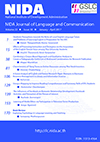A Genre Analysis of English and Korean Research Paper Abltracts in Electronic Resource Management in Library and Information Science
Main Article Content
Abstract
This study aims to answer how the journal article abstract currently represents the main text of the journal article and what role the abstract plays. It also attempts to clarify how the structure of abstracts in Korean and English is different in the same academic area. In order to address this issue systematically, this study examines the textual organization of selected journal article abstracts in library and information science. Specifically, it focuses on the investigation of rhetorical structures and linguistic realizations based on the theoretical framework of “move analysis” as originally proposed by Swales (1990) and Hyland (2000). The results of this study clearly point out that there are differences in the frequency of the occurrence and distribution of five structural moves (introduction-purpose-method-results-conclusion). An abstract in English predominantly uses the introduction move, resulting in the preferred structure of “introduction-purpose-method,” while in Korean there is a predilection toward the results move means a likely “introduction-purpose-methodresults” structure. Furthermore, whereas most journal articles allocate a small portion to the method part in the abstract, this research found that English language abstracts in library and information science allocate the longest portion to the method move part, which consists of 46 words on average. In contrast, in Korean language abstracts, the results move is the longest move, with an average of 40 words.
Article Details
ข้อกำหนดลิขสิทธิ์
- บทความที่ตีพิมพ์ในวารสาร NIDA Journal of Language and Communication ถือเป็นสิทธิ์ของผู้เขียนบทความกับคณะภาษาและการสื่อสารเฉพาะในการตีพิมพ์ครั้งแรกนี้ หลังจากนั้น ถือเป็นสิทธิ์ของผู้เขียนเท่านั้น ผู้ใดต้องการตีพิมพ์ซ้ำ ต้องได้รับอนุญาตจากผู้เขียนก่อน
- กองบรรณาธิการจะส่งวารสารที่มีบทความของผู้เขียนตีพิมพ์ให้แก่ผู้เขียนจำนวน 2 ฉบับ หากผู้เขียนขอรับวารสารที่มีบทความที่ตีพิมพ์เพิ่มเติม สามารถส่งคำขอมายังบรรณาธิการ

